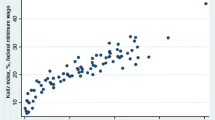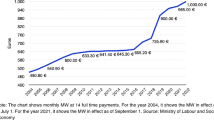Abstract—
The article is devoted to the study of the qualification properties of the Russian labor market, the analysis of the level of wages in various sectors of the economy, including in terms of the ratio of industry wages in Russia and the United States. As part of the analysis, types of activities are distinguished, with relatively lower wages and lower labor productivity, confirms the validity of the thesis of insufficient labor efficiency in conditions of low wages. Eliminating disproportions in the wage levels of workers in the sectors with the lowest level of labor productivity (compared to the proportions emerging for these sectors in developed countries) will have the greatest impact on increasing labor productivity in the economy as a whole. Due to this factor, it is possible to ensure an increase in total labor productivity by 17.9% in the next five years.
Similar content being viewed by others
Notes
Here and below, the calculations consider the traditional concept of labor productivity, calculated as the quotient of dividing gross value added at constant prices by labor inputs (average annual number of employees).
The indicator of the quality of the workplace was the value of the annual earnings of the employee at the main place of work.
It was calculated as the sum of the categories “drivers and machinists of mobile equipment,” “sellers,” “unskilled workers,” methodology [11].
The hidden payroll was calculated as the difference between the total payroll (Rosstat, the structure of monetary incomes of the population) and the payroll of employees of organizations, obtained by multiplying the average number of employees of organizations by their average monthly nominal accrued wages (in terms of the year).
E. S. Uzyakova, “Informal employment and its impact on household income and economic growth,” Stud. Russ. Econ. Dev. 33, 716–722 (2022).
For calculations, we used WIOD statistics for 2014 and the OECP database (oecd.org).
Calculated using the exchange rates of the national currencies of the countries in question.
For the calculation, the statistics of the National Bureau of Statistics of China were used (taking into account the share of employment in the urban private and public sectors, which was 56% of the total number of employed in 2018), Rosstat of the Russian Federation.
Calculated as a quotient of dividing gross output by employed; Rosstat data, input–output tables for 2017.
Percentage increase in earnings with an increase in the duration of education by one year. In other words, it is a modified version of the standard indicator of relative earnings for certain educational groups.
In the structure of the employed by the level of education, they include the following categories of workers: employed with a secondary general education or a basic general education, or those without a basic general education.
It is calculated as the quotient of dividing the number of hours worked per year in all types of work for the production of goods and services by type of economic activity by the average annual number of employees.
If it is impossible to measure the level of labor productivity of unskilled workers, we will use the ratio for labor productivity of workers in the informal sector. In our opinion, the level of productivity of informal workers should roughly match (or exceed) the productivity of low-skilled workers, and the number of people employed in the informal sector in 2020 was almost equal to the number of low-skilled workers (19.0% compared to 19.7%).
The score was obtained in the work: E. S. Uzyakova, “Informal employment and its impact on household income and economic growth,” Stud. Russ. Econ. Dev. 33, 716–722 (2022).
M. N. Uzyakov, “Usage efficiency of primary resources as an indicator of technological development: A retrospective analysis and forecast,” Stud. Russ. Econ. Dev. 22, 111–121 (2011).
REFERENCES
A. V. Suvorov, N. V. Suvorov, V. G. Grebennikov, V. N. Ivanov, O. N. Boldov, M. D. Krasil’nikova, and N. V. Bondarenko, “Approaches to measuring the dynamics and structure of human capital and assessing its accumulated impact on economic growth,” Stud. Russ. Econ. Dev. 25, 215–224 (2014).
I. N. Dolgova, E. A. Edinak, A. G. Korovkin, and I. B. Korolev, “Coordination of supply and demand in the regional labor markets of the Russian Federation, taking into account the educational characteristics of the workforce,” in Scientific Works: Institute of National Economic Forecasting, Russian Academy of Sciences, Ed. by A. G. Korovkin (MAKS, Moscow, 2017), pp. 511–529.
A. G. Korovkin, I. N. Dolgova, and I. B. Korolev, “Analysis and modeling of the interrelated dynamics of the labor market and the education system in the Russian economy,” in Scientific Works: Institute of National Economic Forecasting, Russian Academy of Sciences, Ed. by A. G. Korovkin (MAKS, Moscow, 2010), pp. 664–681.
A. G. Korovkin, I. B. Korolev, and E. A. Edinak, “Educational characteristics of the labor force as a factor in coordinating supply and demand in the Russian labor market,” in Scientific Works: Institute of National Economic Forecasting, Russian Academy of Sciences, Ed. by A. G. Korovkin (MAKS, Moscow, 2015), pp. 222–239.
A. G. Korovkin, I. N. Dolgova, and I. B. Korolev, “Coordination of demand for labor force and its supply, taking into account educational characteristics: A regional aspect,” in Scientific Works: Institute of National Economic Forecasting, Russian Academy of Sciences, Ed. by A. G. Korovkin (MAKS, Moscow, 2016), pp. 501–523.
R. I. Kapelyushnikov, “How much is Russia’s human capital worth?,” Preprint WP3/2012/06, NIU VShE (Higher School of Economics, Moscow, 2012).
J. M. Keynes, The General Theory of Employment, Interest, and Money (Palgrave Macmillan, London, 1936; Gelios ARV, Moscow, 2002).
V. E. Gimpel’son and R. I. Kapelyushnikov, “Evolution of the structure of jobs in Russia: Polarization, improvement, stagnation,” Vopr. Ekon., No. 1, 59–85 (2023). https://doi.org/10.32609/0042-8736-2023-1-59-85
E. O. Wright and R. E. Dwyer, “Patterns of job expansions in the USA. A comparison of the 1960s and 1990s,” Socio-Econ. Rev. 1, 289–325 (2003). https://doi.org/10.1093/soceco/1.3.289
D. Oesch and G. Piccitto, “The polarization myth: Occupational upgrading in Germany, Spain, Sweden, and the UK 1992–2015,” Work Occup. 46, 441–469 (2019). https://doi.org/10.1177/0730888419860880
A. A. Shirov and V.V. Potapenko, “The labor market and the quality of human capital,” EKO 48 (2), 18–34 (2018).
Post-Crisis Recovery of the Economy and the Main Directions of the Forecast of the Socio-Economic Development of Russia for the Period Up to 2035. Scientific Report, Ed. by A. A. Shirov (Nauka, Moscow, 2020) [in Russian].
A. A. Shirov, M. N. Uzyakov, and E. S. Uzyakova, “Redistribution of primary incomes of the population as a factor in reducing inequality and accelerating economic growth at the regional level,” Ekon. Reg. 18, 423–436 (2022). https://doi.org/10.17059/ekon.reg.2022-2-9
E. S. Uzyakova, “Labor productivity and economic growth opportunities,” EKO 50 (6), 87–110 (2020). https://doi.org/10.30680/ESO0131-7652-2020-6-87-110
R. I. Kapelyushnikov, “Return on education in Russia: Rock-bottom?,” Vopr. Ekon., No. 8, 37–68 (2021).
R. Solow, “Technical change and the aggregate production function,” Rev. Econ. Stat. 39, 312–320 (1957);
R. Solow, “A contribution to the theory of economic growth,” Q. J. Econ. 70, 65–94 (1956).
L. F. Katz and K. M. Murphy, “Changes in relative wages 1963–1987: Supply and demand factors,” Q. J. Econ. 107, 35–78 (1992). https://doi.org/10.2307/2118323
Social Policy in Russia: Problems and Solutions. Scientific Report of the Institute of Economic Forecasting of the Russian Academy of Sciences, Ed. by A. A. Shirov (Artik Print, Moscow, 2021) [in Russian]. https://doi.org/10.47711/sr1-2021
E. A. Edinak and A. A. Shirov “Assessment of the relationship between the qualification structure of employment and household consumption using input–output tables,” Stud. Russ. Econ. Dev. 32, 593–602 (2021).
Author information
Authors and Affiliations
Corresponding author
Ethics declarations
The author declares that she has no conflicts of interest.
Rights and permissions
About this article
Cite this article
Uzyakova, E.S. Compensation and the Quality of the Labor Force in Russia. Stud. Russ. Econ. Dev. 34, 507–515 (2023). https://doi.org/10.1134/S1075700723040159
Received:
Revised:
Accepted:
Published:
Issue Date:
DOI: https://doi.org/10.1134/S1075700723040159




